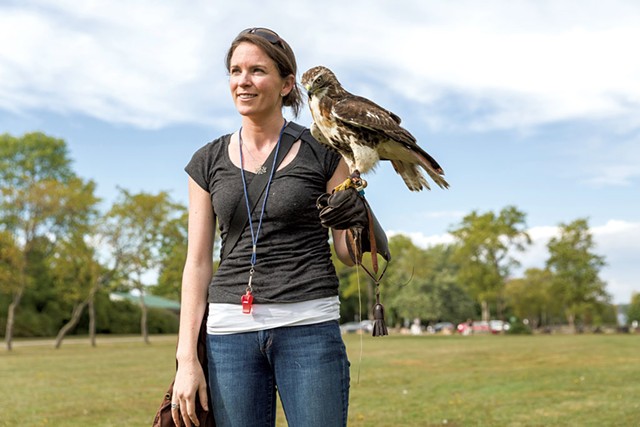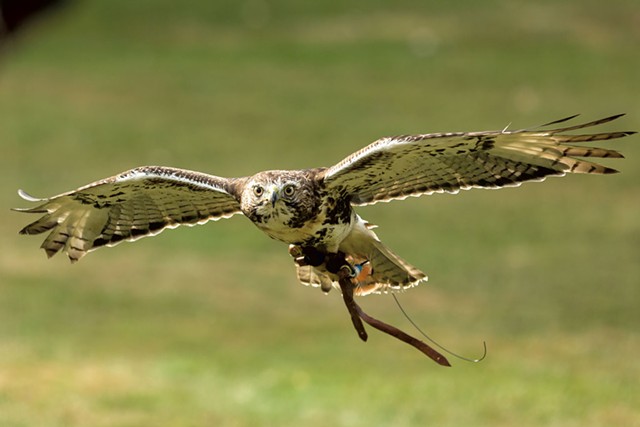
- Oliver Parini
- Austin Ebbott with Ollie
Ollie was almost too fat to fly — not that this journalist's untrained eye could spot an excess ounce or two on a 1.6-pound red-tailed hawk. That anatomical assessment came from Austin Ebbott as she donned a thick leather glove and lifted the young raptor out of her car to take him flying.
Ebbott, 26, belongs to a rare breed of Vermonters: those who practice the ancient sport of falconry. Only 12 Vermonters are currently licensed to hunt with birds of prey, according to the Vermont Fish & Wildlife Department (FWD), and even fewer keep birds of their own. Ebbott, a licensed apprentice falconer who divides her time between Manchester and Burlington, is one of just four Vermont women who do so.
Once the exclusive realm of sultans, kings and emperors, falconry remains a rarefied sport, and with good reason. Keeping a hawk is less a pastime than an all-consuming lifestyle, demanding huge commitments of time, money and attention to detail.
Consider Ollie's weight. Like most falconers, Ebbott focuses intensely on it. She's been known to weigh her bird several times a day and can cite subtle caloric distinctions in the effects that quail, beef, chicken and rabbit meat have on his body.
"It's a delicate balance," she explained, while adjusting the jesses, or leather restraints, affixed to Ollie's legs. "To train him, I had to get him to a weight where he's hungry enough where he wants to work — but not too hungry so he lacks energy when he's chasing the prey."
This particular outing, in Burlington's Oakledge Park early last week, was their last together. After Ollie's 10 months in captivity, Ebbott would release him back into the wild on Sunday. Eighty percent of juvenile red-tailed hawks die in their first year due to starvation or other mishaps, she noted. Fattening him up beyond his normal flying weight was, in effect, just the conclusion of everything she's done for the young tiercel since last fall — giving him a head start in life.
As Ebbott entered a grassy field with Ollie on her gloved fist, nearby sparrows and chipmunks instantly alerted one another to the predator's presence with urgent chirps and clicks. Ollie barely moved a muscle until Ebbott cast him into the wind with a wide sidearm sweep.
The hawk soared to the top of a nearby tree, his mottled brown and white feathers camouflaging him within the branches. The occasional jingle of brass bells on Ollie's ankles helped us pinpoint his location, as would a tiny radio transponder attached to one leg if he flew beyond Ebbott's line of sight. But neither form of telemetry, ancient or modern, guaranteed his return.
"He has the choice, every single time we're out flying, to come back to me or not. I can't force him to do anything," Ebbott noted.
Had she actually been hunting with Ollie that afternoon, Ebbott said, she would have brought him to a wilder area, such as Burlington's Intervale, which offers better quarry. She'd position him in a tree, then beat the bushes below with a large stick to flush out rabbits, squirrels, mice, chipmunks or voles.
On this particular afternoon, however, Ebbott was simply demonstrating Ollie's abilities, and her own. "People get into falconry for many reasons," she said. "Some people enjoy the sport of small-game hunting. I got into it because I think it's cool that he allows me to come into his world and help him find prey."
But Ebbott said she never confused the trust that Ollie placed in her with the devotion and affection of, say, a family dog.
"I definitely have a deep love and respect and admiration for him," she continued. "Sometimes I think he just thinks of me as a refrigerator."
With that, Ebbott opened a plastic baggie filled with chunks of day-old chicks, held one between her gloved fingers and blew a whistle. No response.
"He's in his petulant-teenager phase," she said apologetically, then whistled again.
This time, Ollie practically did a freefall from the treetop, carving a silent parabola above the grass at waist height; with barely a flutter of his wings, he alighted on Ebbott's fist. Glance away for a second, and you'd completely miss his stealth approach — a potentially fatal error, if you happened to be a rodent within a quarter-mile radius. Little wonder that falconer Helen Macdonald, author of the recent New York Times best-seller H Is for Hawk, referred to her goshawk as "thirty ounces of death in a feathered jacket."

- Oliver Parini
- Ollie the red-tailed hawk
Ebbott often geeks out on hawk talk. Red-tailed hawks are extremely energy efficient, she noted, citing one study, from the Cornell Lab of Ornithology, that found the raptors spend 96 percent of their day sitting still and only fly when they must.
Ebbott wasn't always a bird nerd; she didn't even like birds as a child, she admitted. A native of Redding, Conn., she grew up in Manchester, Vt., with house pets — dogs, cats, guinea pigs, a rat — but never any of the "feathered variety."
A few years ago, a family friend introduced Ebbott to Rob Waite, a master falconer and 18-year director of the British School of Falconry in Manchester. When America's first-ever falconry school shut its doors after Tropical Storm Irene, Waite assumed ownership and moved it to a new location under its current name, Green Mountain Falconry School. It was there that Ebbott discovered her "obsession."
By law, Ebbott had to apprentice under a general or master falconer before getting her own license. Waite, who already had an apprentice at the time, was reluctant to take on another.
"To be honest, one is plenty. But she was persistent," Waite recalled. "One of the reasons I was willing to take on Austin was because when I saw her working with birds, I could tell she was a very quick learner and just had the right reactions in every situation."
Ebbott, who currently works as a vet technician in Shelburne while preparing for veterinary school, shadowed Waite for two years before obtaining her falconer's license. That entailed paying a $250 state application fee, taking a hunter safety course and passing an exam on falconry. Next, she had to build housing for a raptor, get it inspected by the FWD and then find a bird of her own.
That last step is easier said than done. Apprentice falconers in Vermont may only possess a red-tailed hawk that's been trapped in the wild as a juvenile. General and master falconers are permitted to keep other raptors, too, including nonnative species and birds bred in captivity.
Why do apprentices keep only red-tailed hawks? Mostly because they're so abundant, explained Jon Kart, the FWD wildlife biologist who issues Vermont's falconry licenses. Hawks leave the nest in summer and have just a few months to learn how to fly and hunt and find a home territory. As most won't survive the winter, the state allows falconers to trap juveniles between September 1 and January 25.
Ebbott captured Ollie in November 2015 near Addison County's Snake Mountain. As she explained, that task alone is enough to weed out all but the most committed would-be falconers.
It began, she explained, with driving for days on end, scouring roadside trees and power poles for a trace of her quarry. Juvenile red-tailed hawks were rare in 2015 owing to the previous long, harsh winter. When Ebbott finally spotted one, she'd drive up slowly, gently place a wire trap baited with gerbils on the ground, then drive away, watch from afar and wait. And wait.
"It looks a little sketchy, driving back and forth and looking through binoculars," Ebbott admitted with a laugh.
How long did it take her to catch Ollie? "He was relatively quick, actually, about 40 hours of driving," she recalled. "There was another falconer who tried for four months last year and didn't get one. It was a really tough year."
That was only the beginning of a long and intense training process, one that Kart likens to "having a baby." Ebbott brought Ollie home and set him up in a dark basement with a hood over his head, which has a calming effect, like blinders on a horse. Fortuitously, Ebbott trapped Ollie around Thanksgiving, when she didn't have the distraction of work or school. For days, she stayed in the basement with him, often for 20-hour sessions, then slowly increased the light to acclimate him to her presence.
"You're sitting there, literally motionless, eyes averted and trying to be as nonthreatening as possible," she said. "Unlike dogs and other domestic animals, [hawks] don't respond to punishment. So it all has to be positive reinforcement."
Ollie took food from Ebbott's hand within 36 hours of being trapped, which is considered good progress. Soon she was walking him around the neighborhood on her glove, introducing him to potentially anxiety-provoking objects such as dogs, cars and other people. Eventually, Ollie stopped "bating," or trying to fly off her fist while restrained. In typical falconry form, she kept his jesses gripped tight in her glove and "wrapped around my little finger" — which, she pointed out, is the origin of that expression.
Within two weeks, Ebbott was flying Ollie free and getting him to return to the glove. All last winter and spring, she flew him four or five days a week for 40 minutes to two hours at a time. For 10 months, Ebbott reorganized her life to accommodate the hawk's schedule of flying, feeding and hunting; friends began calling her "the crazy bird lady."
Ebbott had planned to release Ollie in the spring — but then he contracted a near-deadly roundworm infection. She nursed him back to health and waited out his summer molt. When two tail feathers didn't grow in properly, she and her mentor grafted in new ones using a centuries-old technique known as "imping," before releasing him near Snake Mountain on Sunday.
In Vermont, falconers aren't required to release wild-caught hawks. Ebbott just felt it was the right thing to do. "He's a wild bird," she said, "and he deserves to go back to the wild."
This fall, Ebbott plans to trap and train another hawk, but she admitted she'll miss Ollie, her first.
"His presence has definitely enriched my life," she added. "I hope it's been the same for him."







Comments (2)
Showing 1-2 of 2
Comments are closed.
From 2014-2020, Seven Days allowed readers to comment on all stories posted on our website. While we've appreciated the suggestions and insights, right now Seven Days is prioritizing our core mission — producing high-quality, responsible local journalism — over moderating online debates between readers.
To criticize, correct or praise our reporting, please send us a letter to the editor or send us a tip. We’ll check it out and report the results.
Online comments may return when we have better tech tools for managing them. Thanks for reading.